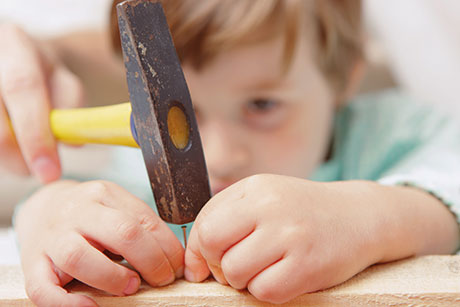
It may seem strange, but children love coming alongside adults to do tasks that they see as important. Helping an adult to build flat-pack furniture or to construct a kit can thrill a child, and also provides plenty of learning opportunities. This means that experiences linked to helping adults ‘construct and assemble’ can be worth planning.
BENEFITS
Children gain hugely from being with adults, especially when engaged in projects that involve assembly.
Physical skills. Depending on the project, children may have the opportunity to practise many physical skills. Children may have to learn to stay still and hold something or use their hand-eye co-ordination to push a bolt through a hole or to fix two edges together.
Language development. Any opportunity to come alongside an adult and to focus on a single activity can be an opportunity for children to talk and to listen. In the case of assembling something, children may also need to follow simple instructions. Children will also gain specific vocabulary linked to the activity, which may include the name of tools and the actions involved in construction.
Cognition. From being involved in construction projects, children can see how things are made and come together. Children can also see the processes involved in manufacturing everyday items as well as the materials that are used around them. From being with an adult, children can also learn some metacognition skills. These are ‘thinking skills’ that adults can model for children by simply talking aloud. They include breaking a task down into specific steps – for example, ‘First we need to check that all the parts are here.’
Emotional development. There are many emotional benefits that should not be underestimated. Children when alongside adults can feel grown-up and responsible. They can also learn appropriate ways of dealing with frustration as they see the adult coping with setbacks. Children can also learn about self-regulation as they see that things that are worthwhile often take time.
PLANNING A PROGRAMME
The starting point is to think about the type of projects that children come alongside adults to do. This type of activity is not about the child doing everything, but instead that they can watch and support the adult. This replicates a traditional way in which adults and children did things together.
It may be that you are ordering furniture or some resources that will need building. You may think also about kits that are aimed at adults or older children, such as making a model robot, putting a clock together using a pre-existing mechanism, or making a dinosaur out of pre-cut cardboard or wood components or model. Children can also benefit from watching things being taken apart – for example, looking at the inside of a phone or clockwork device.
Practical matters
It is important that before involving children, you carry out a rigorous risk assessment. Some projects will no doubt have components that, if children were unsupervised, could cause injury. You should focus on where you will carry out the activity and how many children it will be safe to involve. It is also important to think about how you will keep children engaged during those parts of the assembly where they cannot be directly involved.
Building on assembling projects
From being involved in assembling furniture or a kit, children are likely to want to play what they have done and seen. This lends itself to combining role play with construction play. You could create a ‘workshop’ for children so that they can design and build things. You could also encourage a range of mark-making activities. This might include scribing instructions for them or leaving out pads so that they ‘write’ lists of what to do and then tick them off as they are completed.
In addition, you could also consider inviting in an architect or a designer to show children how they work to transform ideas into 3D projects.
HOME LEARNING
Many parents at some time or another will have to assemble or mend something. It may be unpacking a new television or building a piece of flat-pack furniture. They may not realise that not only will their child be interested, but that there will also be plenty of skills and concepts that their child can learn from the experience. This includes, as we have seen, learning about processes, as well as perseverance.
Creating a display or sharing photographs of their child involved in such activities can give parents confidence. It might also encourage them to see that their child can be involved in quite sophisticated activities, even if the children are just holding the instructions or chatting to them.









